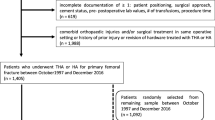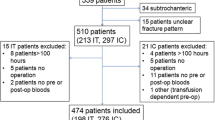Abstract
Introduction
An important percentage of patients affected by hip fracture require the administration of allogenic blood transfusion (ABT) to avoid the risks of perioperative acute anaemia. However, concerns about ABT risks have led to the search for alternatives, especially in elective orthopaedic surgery.
Materials and methods
We have prospectively investigated the effect of preoperative intravenous 200–300 mg (group 2; n=20) iron sucrose on ABT requirements and postoperative morbid-mortality in patients undergoing surgery for displaced subcapital hip fracture (DSHF) repair. A previous series of 57 DSHF patients served as the control group (group 1). All patients were older than 65 years, were operated on the 3rd day after admission to the hospital, by the same medical team, and using the same implant. Age, gender, ASA classification, surgical procedure, perioperative haemoglobin, requirements for ABT, postoperative infection, length of hospital stay (LOS) and 30-day mortality rate were examined.
Results
No adverse reactions to the iron administration were observed. The iron group had a lower transfusion rate (15% vs 36.8%), lower transfusion index (0.26 vs 0.77 units per patient), lower 30d mortality rate (0 vs 19.3%), shorter LOS (11.9 vs 14.1 days), as well as a trend to a lower postoperative infection rate (15% vs 33%).
Conclusion
Preoperative parenteral iron administration could be a safe and effective way to reduce the ABT requirements in DSHF patients. This reduction in the ABT requirements is accompanied by a reduction in the morbid-mortality rate and LOS. A large, randomised, controlled trial to confirm these results is warranted.

Similar content being viewed by others
References
Adunsky A, Lichtenstein A, Mizrahi E, Arad M, Heim M (2003) Blood transfusion requirements in elderly hip fracture patients. Arch Gerontol Geriatr 36:75–81
Andrews NC (1999) Disorders of iron metabolism. N Engl J Med 341:1986–1995
Bellamy MC, Gednaey JA (1998) Unrecognised iron deficiency in critical illness. Lancet 352:1903
Bernière J, Dehullu JP, Gall O, Murat I (1998) Intravenous iron in the treatment of postoperative anaemia in surgery of the spine in infants and adolescents. Rev Chir Orthop 84:319–322
Bertrán A, Muñoz M (2002) Incidencia y riesgos de la anaemia en cirugía ortopédica y traumatológica. In: Muñoz M (ed) Anaemia y transfusión en cirugía. SPICUM, Málaga, pp 49–64
Biesma DH, Van De Wiel A, Beguin Y, Keraaijenhagen RJ, Marx JJM (1995) Post-operative erythropoiesis is limited by the inflammatory effect of surgery on iron metabolism. Eur J Clin Invest 25:383–389
Breymann C, Richter C, Hüttner C, Huch R, Huch A (2000) Effectiveness of recombinant erythropoietin and iron sucrose vs. iron therapy only, in patients with postpartum anaemia and blunted erythropoiesis. Eur J Clin Invest 30:154–161
Carson JL, Altman DG, Duff A, Noveck H, Weinstein MP, Sonnenberg FA et al (1999) Risk of bacterial infection associated with allogenic blood transfusion among patients undergoing hip fracture repair. Transfusion 39:694–700
Cazzola M, Ponchio L, Benedetti F de, Ravelli A, Rosti V, Beguin Y et al (1996) Defective iron supply for erythropoiesis and adequate endogenous erythropoietin production in the anaemia associated with systemic-onset juvenile chronic arthritis. Blood 87:4824–4830
Cuenca J, García-Erce JA, Muñoz M, Izuel M, Martínez AA, Herrera A (2004) Patients with pertrochanteric hip fracture may benefit from preoperative intravenous iron therapy: a pilot study. Transfusion 44:1447–1452
García-Erce JA, Cuenca J, Solano V (2003) Factores predictivos de la necesidad de transfusión en la fractura subcapital de cadera en pacientes de más de 65 años. Med Clin (Barc) 120:161–166
Garden RS (1961) Low-angle fixation in fractures of the femoral neck. J Bone Joint Surg Br 43:647–663
Gasché C, Waldhor T, Feichtenschlager T, Male C, Mayer A, Mittermaier C et al (2001) Prediction of response to iron sucrose in inflammatory bowel disease-associated anaemia. Am J Gastroenterol 96:2382–2387
Goldacre MJ, Roberts SE, Yeates D (2002) Mortality after admission to hospital with fractured neck of femur: database study. Br Med J 325:868–869
Goodnough LT, Merkel K (1996) Parenteral iron and recombinant human erythropoietin therapy to stimulate erythropoiesis in patients undergoing repair of hip fracture. Hematology 1:163–166
Goodnough LT, Shander A, Spence R (2003) Bloodless medicine: clinical care without allogeneic blood transfusion. Transfusion 43:668–676
Grimes JP, Gregory PM, Noveck H, Butler MS, Carson JL (2002) The effects of time-to-surgery on mortality and morbidity in patients following hip fracture. Am J Med 112:702–709
Halm EA, Wang JJ, Boockvar K, Penrod J, Silberzweig SB, Magaziner J et al (2003) Effects of blood transfusion on clinical and functional outcomes in patients with hip fracture. Transfusion 43:1358–1365
Halm EA, Wang JJ, Boockvar K, Penrod J, Silberzweig SB, Magaziner J et al (2004) The effect of perioperative anaemia on clinical and functional outcomes in patients with hip fracture. J Orthop Trauma 18:369–374
Herrera A, Domingo J, Calvo A, Martínez AA, Cuenca J (2002) A comparative study of trochanteric fractures treated with the Gamma nail or the proximal femoral nail. Int Orthop (SICOT) 26:165–169
Hill GE, Frawley WH, Griffith KE, Forestner JE, Minei JP (2003) Allogeneic blood transfusion increases the risk of postoperative bacterial infection: a meta-analysis. J Trauma 54:908–914
Horan TC, Gaynes RP, Martone WJ, Jarvis WR, Emori TG (1992) Centers for Disease Control definitions of nosocomial surgical site infections, 1992: a modification of CDC definitions of surgical wound infections. Infect Control Hosp Epidemiol 13:606–608
Koval KJ, Rosenberg AD, Zuckerman JD, Aharonoff GB, Skovron ML, Bernstein RL et al (1997) Does blood transfusion increase the risk of infection after hip fracture? J Orthop Trauma 11:260–265
Lawrence VA, Silverstein JH, Cornell JE, Pederson T, Noveck H, Carson JL (2003) Higher Hb level is associated with better early functional recovery after hip fracture repair. Transfusion 43:1717–1722
Levi N (1996) Blood transfusion requirements in intracapsular femoral neck fractures. Injury 27:709–711
Levi N, Sandberg T (1998) Blood transfusion and postoperative wound infection in intracapsular femoral neck fractures. Bull Hosp Infect Dis 57:69–73
MacDougall IC (2000) Intravenous administration of iron in epoetin-treated haemodialysis patients—which drugs, which regimen? Nephrol Dial Transplant 15:1743–1745
McBride DJ, Stother IG (1988) Blood transfusion requirements in elderly patients with surgically treated fractures of the femoral neck. J R Coll Surg Edimb 33:311–313
New classification of physical status (1963) Anesthesiology 24:111
Orosz GM, Magaziner J, Hannan EL, Morrison RS, Koval K, Gilbert M et al (2004) Association of timing of surgery for hip fractures and patients outcomes. JAMA 291:1738–1743
Schmidt AH, Templeman DC, Kyle RF (1998) Blood conservation in hip trauma. Clin Orthop 357:68–73
Scottish Intercollegiate Guidelines Network (2001) Perioperative blood transfusion for elective surgery. A national clinical guideline. www.sign.ac.uk.
Scrimshaw NS, Sangiovanni JP (1997) Synergism of nutrition, infection, and immunity: an overview. Am J Clin Nutr 66:464S–477S
Silverstein SB, Rodgers GM (2004) Parenteral iron therapy options. Am J Hematol 76:74–78
Swain DG, Nightingale PG, Patel JV (2000) Blood transfusion requirements in femoral neck fracture. Injury 31:7–10
Vamvakas EC (2002) Possible mechanisms of allogeneic blood transfusion-associated postoperative infection. Transfusion Med Rev 18:144–160
Van Iperen CE, Gaillard CA, Kraaijenhagen RJ, Braam BG, Marx JJ, Van de Wiel A (2000) Response of erythropoiesis and iron metabolism to recombinant human erythropoietin in intensive care unit patients. Crit Care Med 28:2773–2778
Van Iperen CE, Kraaijenhagen RJ, Biesma DH, Beguin Y, Marx JJM, Van de Wiel A (1998) Iron metabolism and erythropoiesis after surgery. Br J Surg 85:41–45
Zauber NP, Zauber AG, Gordon FJ, Tillis AC, Leeds HC, Berman E et al (1992) Iron supplementation after femoral head replacement for patients with normal iron stores. JAMA 267:525–527
Zuccala G, Pahor N, Landi F, Gasparini G, Pagano F, Cabonin P, Cocchi A (1997) Use of calcium antagonist and need for preoperative transfusion in older patients with hip fracture: observational study. Br Med J 314:643–644
Acknowledgement
We gratefully acknowledge the manuscript reviewing by Dr. J.H. Palmer (Department of Anaesthesiology, Clínica Santa Elena, Torremolinos, Spain).
Author information
Authors and Affiliations
Corresponding author
Rights and permissions
About this article
Cite this article
Cuenca, J., García-Erce, J.A., Martínez, A.A. et al. Role of parenteral iron in the management of anaemia in the elderly patient undergoing displaced subcapital hip fracture repair: preliminary data. Arch Orthop Trauma Surg 125, 342–347 (2005). https://doi.org/10.1007/s00402-005-0809-3
Received:
Published:
Issue Date:
DOI: https://doi.org/10.1007/s00402-005-0809-3




